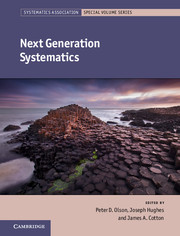Book contents
- Frontmatter
- Contents
- List of contributors
- Introduction: studying diversity in an era of ubiquitous genomics
- Part I Next Generation Phylogenetics
- 1 Perspective: Challenges in assembling the ‘next generation’ Tree of Life
- 2 The role of next generation sequencing technologies in shaping the future of insect molecular systematics
- 3 Phylogenomics of Nematoda
- 4 High-throughput multiplexed mitogenomics for Metazoa: prospects and limitations
- 5 Investigating bacterial microevolution through next generation sequencing
- Part II Next Generation Biodiversity Science
- Part III Next Generation Challenges and Questions
- Index
- Systematics Association Special Volumes
- Plate section
- References
5 - Investigating bacterial microevolution through next generation sequencing
from Part I - Next Generation Phylogenetics
Published online by Cambridge University Press: 05 June 2016
- Frontmatter
- Contents
- List of contributors
- Introduction: studying diversity in an era of ubiquitous genomics
- Part I Next Generation Phylogenetics
- 1 Perspective: Challenges in assembling the ‘next generation’ Tree of Life
- 2 The role of next generation sequencing technologies in shaping the future of insect molecular systematics
- 3 Phylogenomics of Nematoda
- 4 High-throughput multiplexed mitogenomics for Metazoa: prospects and limitations
- 5 Investigating bacterial microevolution through next generation sequencing
- Part II Next Generation Biodiversity Science
- Part III Next Generation Challenges and Questions
- Index
- Systematics Association Special Volumes
- Plate section
- References
Summary
Introduction
There is no doubt that since 1995 when the first two bacterial genomes were fully sequenced, Haemophilus influenzae (Fleischmann et al. 1995) and Mycoplasma genitalium (Fraser et al. 1995), our understanding of bacterial pathogens has benefited hugely from the wealth of information provided by high-quality reference bacterial genomes. Over the past 20 years, comparative analyses of these reference genomes has unravelled many of the mechanisms of pathogenicity. However, we are now in the age of NGS, which has revolutionized the field of comparative genomics, allowing evolutionary adaptations to be placed in a more resolved phylogenetic framework, and the emergence of virulence, pathogenicity and antibiotic resistance to be reconstructed far more accurately. The fine-scale resolution and low cost of NGS permit investigations of genome variation at an unprecedented scale, within an individual species or even at the level of individual disease outbreaks or bacterial populations within a patient. Furthermore, simple tweaks to the methodologies can provide a wealth of functional information that, when placed in a phylogenetic context, drives our understanding of pathogen biology even further forward. Here, we provide a review of recent progress in the field of bacterial genomics, and its impact both clinically and intellectually on our knowledge of bacterial pathogens.
Historical context: molecular typing of bacteria
To understand the evolution and spread of bacterial pathogens, it is essential to not only discriminate between species, but also have the ability to discriminate at the subspecies level. Researchers across all fields of microbiology depend on molecular typing techniques in order to obtain the resolution to investigate population structure (Maiden et al. 1998), molecular evolution (Feil et al. 1999), epidemiological tracking (Foley et al. 2009) and phenotypic variation (Brown et al. 2010). Furthermore, molecular typing techniques are instrumental in the clinical setting to provide precise diagnoses of infections (Goering et al. 2013). Traditional molecular typing techniques typically depend on the sequencing of a small number of loci. The speed and process by which these loci evolve vary depending on the bacteria in question, each bringing its own advantages and limitations. For Mycobacterium tuberculosis, which causes TB, variable number tandem repeats (VNTRs) and insertion sequences (IS elements), including IS6110, are typically used as the typing loci because they have a relatively high genetic turnover, allowing some level of discrimination in what is an extremely clonal pathogen with a very slow mutation rate.
- Type
- Chapter
- Information
- Next Generation Systematics , pp. 101 - 120Publisher: Cambridge University PressPrint publication year: 2016

